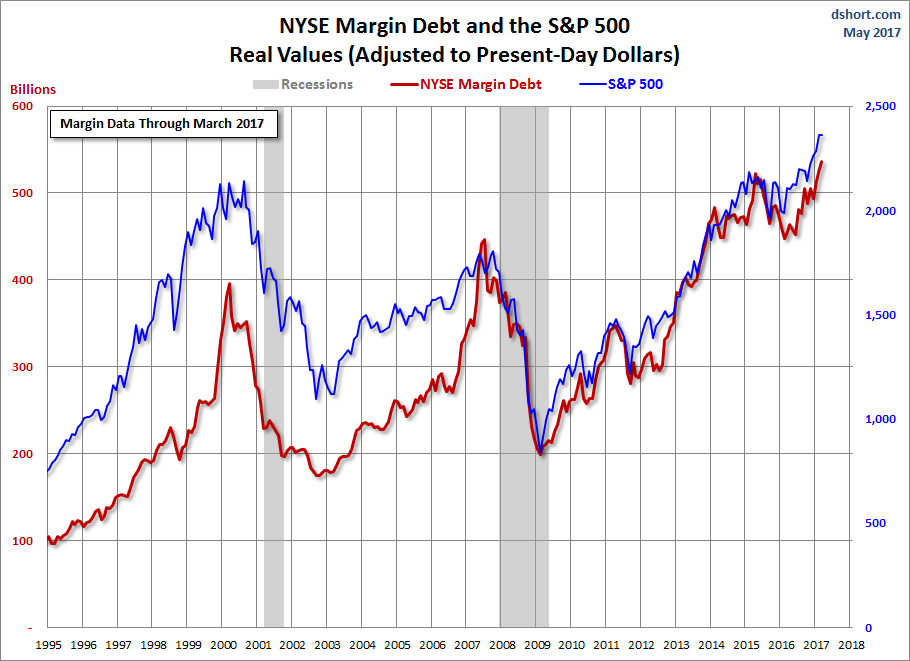Stocks & Equities
Note: The NYSE has released new data for margin debt, now available through March.
The New York Stock Exchange publishes end-of-month data for margin debt on the NYX data website, where we can also find historical data back to 1959. Let’s examine the numbers and study the relationship between margin debt and the market, using the S&P 500 as the surrogate for the latter.
The first chart shows the two series in real terms — adjusted for inflation to today’s dollar using the Consumer Price Index as the deflator. At the 1995 start date, we were well into the Boomer Bull Market that began in 1982 and approaching the start of the Tech Bubble that shaped investor sentiment during the second half of the decade. The astonishing surge in leverage in late 1999 peaked in March 2000, the same month that the S&P 500 hit its all-time daily high, although the highest monthly close for that year was five months later in August. A similar surge began in 2006, peaking in July 2007, three months before the market peak.
Debt hit a trough in February 2009, a month before the March market bottom. It then began another major cycle of increase.
The Latest Margin Data
The NYSE has released new data for margin debt, now available through March. The latest debt level is up 1.7% month-over-month. The current level is at another record high. Note the inflation-adjusted version is also at its record high. The March data gives us an additional sense of investor behavior since the start of the new administration.



 Donald Trump has made good on one of his most audacious campaign promises by submitting what he describes as the biggest tax cut in U.S. History. For once, at least, this does not appear to be Trumpian braggadocio. It really may be the mother of all tax cuts. But if passed, what may this bunker buster do to the economy? While I have rarely met a tax cut I didn’t like, this one just may be more likely to send the economy into a downward spiral than it is to send up to orbit.
Donald Trump has made good on one of his most audacious campaign promises by submitting what he describes as the biggest tax cut in U.S. History. For once, at least, this does not appear to be Trumpian braggadocio. It really may be the mother of all tax cuts. But if passed, what may this bunker buster do to the economy? While I have rarely met a tax cut I didn’t like, this one just may be more likely to send the economy into a downward spiral than it is to send up to orbit.
 While there’s been plenty of focus on apps and cloud computing in the technology space, advances are also being made in hardware-focused sectors such as nanotechnology. Uses include everything from more efficient drug delivery systems to tiny transistors that allow for smaller and more powerful computer chips.
While there’s been plenty of focus on apps and cloud computing in the technology space, advances are also being made in hardware-focused sectors such as nanotechnology. Uses include everything from more efficient drug delivery systems to tiny transistors that allow for smaller and more powerful computer chips.
To be sure, the markets for nanotechnology products and nanotechnology uses are set to grow in the coming years. A report released this past December from Research and Markets states that nanotechnology “is a rapidly growing technology” and the global industry has been forecast to grow annually by 17 percent up to 2024.
Similarly, BCC Research has said that the global nanotechnology market was valued at $39.2 billion in 2016 and should grow at a CAGR of 18.2 percent, in order that the market will reach a believed $90.5 billion by 2021.
Still, for investors just starting to look at nanotechnology stocks, it can be difficult to know where to to begin, as nanotechnology uses are so varied. As a starting point, here’s an overview of six of the top areas in which nanotechnology uses are making a big difference today.
Materials and coatings

Last week, as the Nasdaq Composite Index crossed 6,000 for the first time, Robert Shiller, a Nobel laureate economist, made the rounds in the financial press.
He’s worried. Valuations are historically high. A crash is coming, eventually, he argues.
With his carefully measured tone and impeccable academic pedigree — he’s a professor at the Yale School of Management — Shiller is the perfect pundit.
Jesse Livermore, the tenacious trader immortalized in the 1923 investment classic Reminiscences of a Stock Operator, warned about pundits. He hated tips and claimed following them had lost him hundreds of thousands of dollars.
He learned to trust his own analysis. He learned to trust the power of trends and to ignore punditry.
Shiller’s concern is based on something called the Cyclically Adjusted Price-to-Earnings ratio, better known as the CAPE. It’s a valuation model that takes a conservative ten-year average of corporate earnings and divides by the comparable metric for price. And CAPE has reached levels not seen since 1929 and 2000, two dates that send shivers down most investors’ spines.
The rest of the economic story does not help the bulls’ case, either. Those periods were characterized by extremely high levels of Gross Domestic Product growth. In 2000, GDP growth was north of 4%. Last week, GDP was reported at a measly 0.7%.
 It’s not the first time in recent years that the CAPE has been high. The ratio pushed near current levels in 1998. At the time, the dotcom era was in full stride. In the ensuing two years, the most speculative stocks became even more dear as prices sprinted higher. For example, adjusted for splits, Amazon (AMZN) zoomed from less than $5 in 1998 to $113 in 2000.
It’s not the first time in recent years that the CAPE has been high. The ratio pushed near current levels in 1998. At the time, the dotcom era was in full stride. In the ensuing two years, the most speculative stocks became even more dear as prices sprinted higher. For example, adjusted for splits, Amazon (AMZN) zoomed from less than $5 in 1998 to $113 in 2000.
Something like that could happen again. “We’re in an oddball enough mood,” Shiller admits.
The economist explains that President Trump is a game-changing figure, for better or worse, who wants to disrupt the underlying fundamentals of the capital markets. Changing the corporate tax code would be bullish for stocks in the near term.
However, periods of extreme optimism have an ugly common denominator, Shiller notes with a wry smile. They always lead to crashes.
Shiller is right, empirically. However, that information is not particularly useful.
Livermore understood that the most important attribute of a successful investor is the ability to hold winners. He called this “sitting tight,” and it is not as easy as it appears.
Too many investors want to sell winners quickly. They believe stock strength merits selling. Pundits preach everywhere they can find listeners. They construct models. They get on their soapbox on TV. Stocks are up, sell.
Livermore found just the opposite is true. Strength is validation an investor got it right. Investors are wise to learn to embrace this, learn from it.
They are also wise to challenge pundit assertions. Can their claims pass the test of tested scrutiny?
“Not even a world war can keep the stock market from being a bull market when conditions are bullish, or a bear market when conditions are bearish,” Livermore said. “And all a [trader] needs to know to make money is to appraise conditions.”
Understanding market conditions is one of the cornerstones of the information I provide to members. Valuation models alone are rarely useful. You need to know what to buy and when events change that warrant selling.
Our newsletters show members how to identify big trends, find the right stocks, and most important, how to sit tight for the big money. A lot more money is lost waiting for crashes than during crashes themselves.
Best wishes,
Jon Markman’s Pivotal Point
…also from Martin D. Weiss, Ph.D.:
New, Bigger Shockwaves in Europe!
















